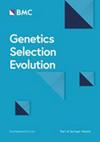利用基因组信息估算配子变异和改善动物种群的循环选择是否有优势?
IF 3.1
1区 农林科学
Q1 AGRICULTURE, DAIRY & ANIMAL SCIENCE
引用次数: 0
摘要
配子变异可以从任何基因型个体的基因组预测结果中预测出来。这在植物育种中被广泛应用,应用效用标准(UC)。本文旨在探讨利用UC进行家畜循环选择的条件。这里,选择候选者的UC是未来后代的期望值(候选者育种值的一半)与其预测配子方差的线性组合,加权系数$$\theta$$进行优化。首先,在前人研究结果的基础上,分析得出了候选品种配子方差与候选品种育种值的比值。该比值在很大程度上取决于影响该性状的数量性状位点(QTL)的数量,而在较小程度上取决于QTL等位基因频率的分布:高度不平衡的频率和有限数量的QTL(< 10)有利于较高的比值值。然后,对无限大群体进行循环选择时的平均育种值和遗传方差的变化进行了分析,并对15代以内的选择进行了分析:在这种理想情况下,5 ~ 10代(取决于$$\theta$$)后,基于UC的选择的预期育种值更高,遗传方差始终高于基于估计育种值的选择。为了描述UC在更一般情况下的潜力,模拟了1000个雄性和1000个雌性的群体,具有不同的QTL选择率、数量和等位基因频率,以及$$\theta$$。这些模拟是在具有已知位置和效应的独立QTL的情况下进行的。$$\theta$$的最佳值(即提供最佳遗传进展)通常低于1,限制了配子方差的权重。正如分析推导所预期的那样,当QTL较少且等位基因频率不平衡时,使用UC的遗传进展增益最大,但它们几乎不超过5个%. We conclude that the key factor to choose selection on UC rather than on estimated breeding values is the ratio between the variance of the gametic standard deviations and the variance of the breeding values (GEBV), which should be carefully evaluated.本文章由计算机程序翻译,如有差异,请以英文原文为准。
Is there an advantage of using genomic information to estimate gametic variances and improve recurrent selection in animal populations?
Gametic variances can be predicted from the outcomes of a genomic prediction for any genotyped individual. This is widely used in plant breeding, applying the utility criterion (UC). This paper aims to examine the conditions to use UC for recurrent selection in livestock. Here, the UC for a selection candidate is the linear combination of the expected value of the future progeny (half of the candidate’s breeding value) and its predicted gametic variance weighted by a coefficient $$\theta$$ to be optimized. First, generalizing previous results, we derived analytically the ratio of the variance of the candidate’s gametic variance and that of half of the candidate’s breeding value. This ratio depends strongly on the number of quantitative trait loci (QTL) affecting the trait and, to a lesser extent, on the distribution of QTL allele frequencies: highly unbalanced frequencies and a limited number of QTL (< 10) favor higher values of the ratio. Then, changes in average breeding values and genetic variances when recurrent selection in a population of infinite size is applied were analytically derived and analyzed for selection up to 15 generations: in this ideal situation, after 5 to 10 generations (depending on $$\theta$$ ), the expected breeding values were higher with selection on UC and the genetic variance was always higher than with selection on estimated breeding values. To describe the potential of the UC in more general situations, simulations were applied to a population of 1000 males and 1000 females, with various selection rates, numbers and allele frequencies of QTL, and $$\theta$$ . These simulations were performed assuming independent QTL with known positions and effects. The best values for $$\theta$$ (i.e. providing the best genetic progress) were generally lower than 1, limiting the weight on the gametic variance. As expected from the analytical derivations, the gain in genetic progress from using UC was greatest when there were few QTL and allele frequencies were unbalanced, but they barely exceeded 5%. We conclude that the key factor to choose selection on UC rather than on estimated breeding values is the ratio between the variance of the gametic standard deviations and the variance of the breeding values (GEBV), which should be carefully evaluated.
求助全文
通过发布文献求助,成功后即可免费获取论文全文。
去求助
来源期刊

Genetics Selection Evolution
生物-奶制品与动物科学
CiteScore
6.50
自引率
9.80%
发文量
74
审稿时长
1 months
期刊介绍:
Genetics Selection Evolution invites basic, applied and methodological content that will aid the current understanding and the utilization of genetic variability in domestic animal species. Although the focus is on domestic animal species, research on other species is invited if it contributes to the understanding of the use of genetic variability in domestic animals. Genetics Selection Evolution publishes results from all levels of study, from the gene to the quantitative trait, from the individual to the population, the breed or the species. Contributions concerning both the biological approach, from molecular genetics to quantitative genetics, as well as the mathematical approach, from population genetics to statistics, are welcome. Specific areas of interest include but are not limited to: gene and QTL identification, mapping and characterization, analysis of new phenotypes, high-throughput SNP data analysis, functional genomics, cytogenetics, genetic diversity of populations and breeds, genetic evaluation, applied and experimental selection, genomic selection, selection efficiency, and statistical methodology for the genetic analysis of phenotypes with quantitative and mixed inheritance.
 求助内容:
求助内容: 应助结果提醒方式:
应助结果提醒方式:


